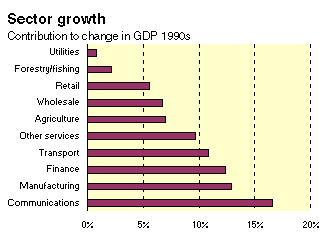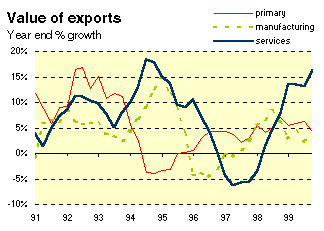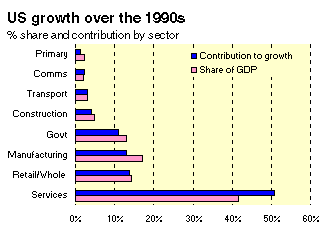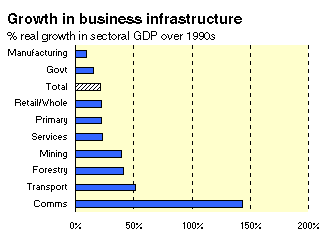Where is the growth coming from?
Enthusiasm, for what many glibly refer to as the knowledge or information economy suggests that is where future growth will emerge from. But what, in concrete terms, constitutes the knowledge/information economy? Telecommunications, media and computing business are those directly involved with the delivery and manipulation of information and constitute the backbone of the emerging information/knowledge economy. These businesses or sectors have been the standout performers in terms of growth most developed economies over the past decade. But will these technology-laden darlings of the sharemarket live up to their hype by continuing to outpace all other sectors in the economy over the next decade? We suspect they will.
In broad terms 80% of the growth in the New Zealand economy over the 1990s originated from service businesses – transport, communications, retail, and business, financial and personal services. Their contribution to growth was well ahead of their share of the total economic activity (66% at the end of the decade). Even in terms of export receipts, where service businesses account for about a quarter of all earnings, their contribution to export growth over the 1990s was impressive at just over 30%.
Although these are historic trends they lend weight to the idea that the information/knowledge/technology intensive service businesses are at the forefront of growth and are likely to remain there, at least for the time being.
Sectoral economic performance over 1990s* | ||||
Primary | Manufacturing | Services | ||
GDP | Share | 8.4% | 23.2% | 65.5% |
Contribution | 9.2% | 12.7% | 79.8% | |
Exports | Share | 37.0% | 38.1% | 24.8% |
Contribution | 37.8% | 31.5% | 30.6% | |
*1989&1990 to 1998&1999 | ||||
Communications
The sector most closely associated with the information revolution – transport and communications – has produced one of the most impressive growth results over the past decade. Not only did the transport and communications sector grow significantly faster (three times) than all other sectors over the past decade, its contribution to overall growth was substantial, at just under 30% – more than the whole of the manufacturing sector. Communications is the dominant contributor (accounting for around two thirds of overall growth within the transport and communications sector).
The development of new cellular phone networks, cable and satellite television systems, the boom in courier traffic, the proliferation of call centres and the explosion in internet and e-mail traffic have all helped deliver real growth in communications sector output of close to 10%pa over the past 10 years. Further rapid growth appears inevitable with major players such as Telstra and Saturn pouring more capital into new networks, the introduction of Telecom’s high speed and high volume international Southern Cross cable, and continuing convergence within the media and telecommunications industries.
Communications infrastructure will be central to the development of e-commerce, which is essentially about bringing businesses together in an electronic, information-rich market place. The more gimmicky and high profile impact of having the internet available on your cell phone (the new wireless application protocol – WAP), and access to hundreds of TV channels, will feed the information revolution, even if it contributes less to overall communications output than core business-to-business services.
One of the most important developments in New Zealand communications sector over the next five years will be the further substantial reduction in the cost of telephony services for users. Providers will add significantly to capacity that will help drive down costs, which remain high by international developed country standards¹.
Graph 3.1

Primary Industries
New Zealand’s primary sector will remain an important component of the economy mainly because of its contribution to generating export earnings. In gross terms its contribution to export growth is still substantial at around 38%. And despite its reputation for being a sector dependent on plodding farmers and weak commodity sellers, its performance over the 1990s has been crucial in sustaining higher growth. The value of primary export earnings rose by nearly 80% over the decade, somewhat faster than manufacturing export receipts.
Although the dairy industry has been at the forefront of growth in primary sector output and exports over the 1990s, the forestry sector is likely to play the lead role over the next five years. In the short term international markets for forest products are likely to remain buoyant with demand strong in most markets and firm international prices.
The volume of wood harvested will increase by around 6%pa over the next five years and more of it will be further processed. At this stage around $350m of new investment in expanding existing, and developing new, processing plants has been announced or planned for the next five years. We expect the actual level of new investment over the next five years to be at least double this amount – over the second half of the 1990s $1bn of new investment in wood processing facilities took place.
The primary sector is a very important source of productivity growth within the economy. Between 1986 and 1998 agricultural total factor productivity (TFP) increased at 3.6%pa, and in the forestry sector by 5.2%pa². By comparison overall TFP in New Zealand over the same 12 year period rose by just 0.8%pa.
Graph 3.2

Manufacturing
The manufacturing sector’s share of total output peaked in the mid-1980s at around 21.5%. Since then it has slipped back slowly to now stand at 17.4%. The sector has been forced by economic reforms, particularly tariff reductions, to rationalise production and in many cases develop export markets for their products.
Over the past 12 years the ratio of exports to total manufactured sales has more than doubled, from 17% to 35% for the year ended March 1999. But the nominal value of manufactured exports has risen more slowly (50%) over the 1990s than has been the case for primary industries (79%).
The sector’s growth prospects rest heavily on the ability of manufacturing firms to expand their exports sales. Despite impressive gains in specific areas of manufacturing (machinery and transport equipment exports rose nearly 150% over the 1990s) the overall export performance of the sector has been lacklustre. The mediocre results reflect:
- The immaturity of the sector when it comes to exporting
- The relatively volatile financial market conditions exporters faced over the 1990s, with 15-20% swings in the value of the real exchange rate
- The steady commoditisation of large tracts of manufacturing (eg clothing).
The sector’s export base remains relatively narrow with a handful of companies accounting for the majority of export receipts. A shortage of skilled labour (technical, managerial, research, marketing), the ability to deliver a steady stream of innovative products, and owners’ reluctance to expand (for a range of reasons) will be the main constraints to future export growth. Nonetheless, we expect the value of manufactured exports to rise strongly over the next two years as a result of a price-competitive currency and buoyant world market demand. This will keep the sector at the forefront of overall economic growth in the short term.
Beyond 2001 the manufacturing sector is likely to revert more to its long-term growth trend (below average) within the economy. Why? A growing number of successful manufacturers will develop new capacity offshore closer to their key markets – even some existing capacity will be closed down in favour of offshore facilities (eg clothing, furniture, whiteware manufacturers). Changes in labour market regulations and a persistent shortage of skilled workers will undermine the competitiveness of small-scale innovation-intensive businesses in New Zealand. Finally, the real exchange is likely to rise within the next five years, reducing the price competitiveness of local production.
Services and the new economy
It should be no great surprise to learn that the services sector has been the standout performer in the economy over the past decade. Not only have services businesses contributed the bulk of economic growth over the 1990s, their 30% contribution to the lift in exports over the decade was well in excess of their 24% share of total export receipts by the end of the 1990s. The dominance of service businesses is typical of developed economies. What is interesting in the case of New Zealand is that growth in service output appears to have been at the expense more of manufacturing than of the primary industries. Two possible explanations are:
- New Zealand’s comparative advantage is in primary production rather than manufacturing
- As manufacturers have narrowed their focus to survive a greater proportion of their output has been outsourced and redefined under services than has been the case for primary industries.
Graph 3.3

Set against this last point, though, is that as more primary output is further processed it gets redefined as manufactured output -primary food processing.
In the US service activities dominate both in terms of share of GDP as well as contribution to growth over the 1990s, but there are marked differences within the services sector between the US and New Zealand. For instance, in New Zealand the contribution to growth from financial and all other services excluding government, over the 1990s was 22%. In the US the figure was just over 50%.
The complete reverse is the case in the transport and communications sectors where growth in New Zealand has been impressive, but very subdued in the US. The contribution of these two sectors to overall growth in the US over the 1990s was a paltry 5.2%. Two reasons might explain the substantial difference: · Either the US data for these two sectors are not really comparable with New Zealand, · Or the US transport and communications sectors completed their fast growth phase earlier as transport and telecommunications were deregulated and trust-busted in the 1970s and 1980s, well before New Zealand deregulated these sectors. New Zealand has simply been a late starter in areas such as cable TV, cellphones, the Internet, etc.
An interesting trend in New Zealand is that the contribution to growth from the financial and other private services sectors has fallen from around 40% over the 1980s to 22% over the past decade. It seems likely that the growth in business services over the past decade has been dominated by products and services that are more closely related to the communications and transport sector – call centres, web developments, couriers, logistics, etc. Supply chain management, for instance, is communications and transport intensive, and is probably doing more to improve companies’ bottom lines than many of the traditional business and financial services such as banking.
The performance of the retail and wholesale trade sectors in both economies has been similar, with the total contribution to growth being around 12% over the past decade.
Graph 3.4

Conclusion
The growth in services activities has dominated the character of economic activity both here and internationally for the past decade or more. We predict that services will continue to outgrow other types of economic activity, but its growth may be constrained by skill shortages, (see article The knowledge economy and skills). But increasingly the distinction between goods production and services will blur. For instance, in agriculture gene technology will enable primary producers to deliver food products that have genuine health attributes. Will farmers, therefore, become part of the health services industry?
More manufacturers will move up the value chain into services and contract actual production to low cost producers in either developing countries or to factories that have significant greater economies of scale than is available in New Zealand. Fisher and Paykel for instance, may eventually become a whiteware design and development company and simply license production to companies in key markets.
In the service sector we expect growth to be concentrated in the IT and communications area and also in personal services. The latter will expand as incomes rise – personal trainers, dining out, lawn-mowing, financial advisors. Incomes will rise as IT and communications services help consumers interact more precisely with producers to deliver cheaper goods and services. An increasing share of that freed-up income will be spent on buying experiences (shows, weekends away, organised adventures) rather than products or services.
2 Measuring New Zealand’s Productivity, D Lawerence and E Diewert, prepared for Reserve Bank of New Zealand and Treasury, March 1999, p76.




